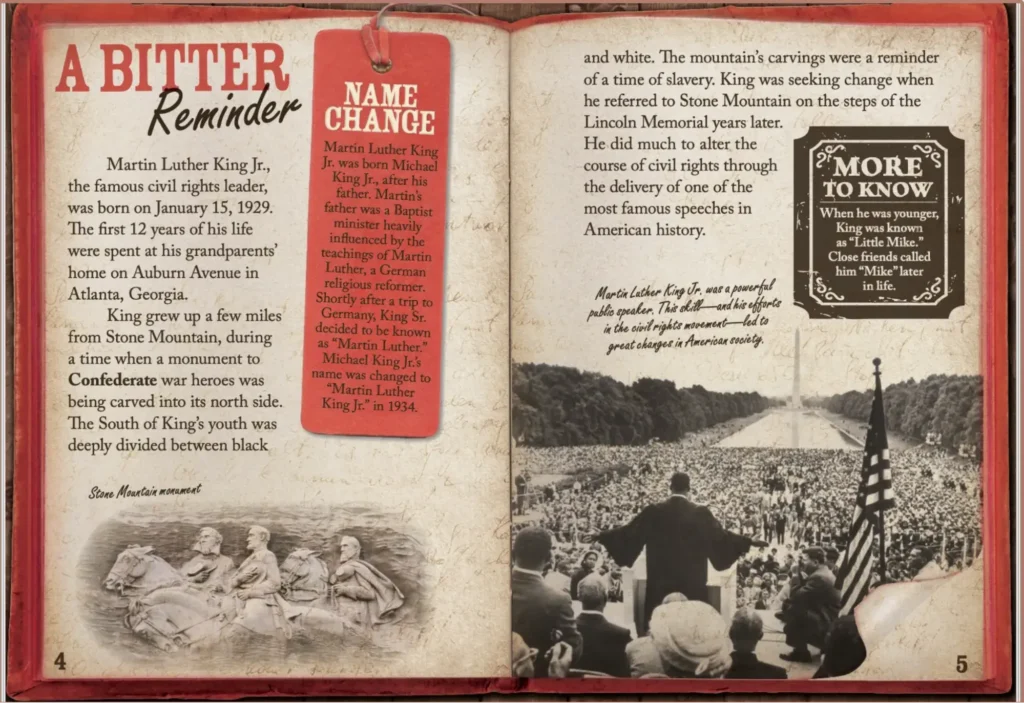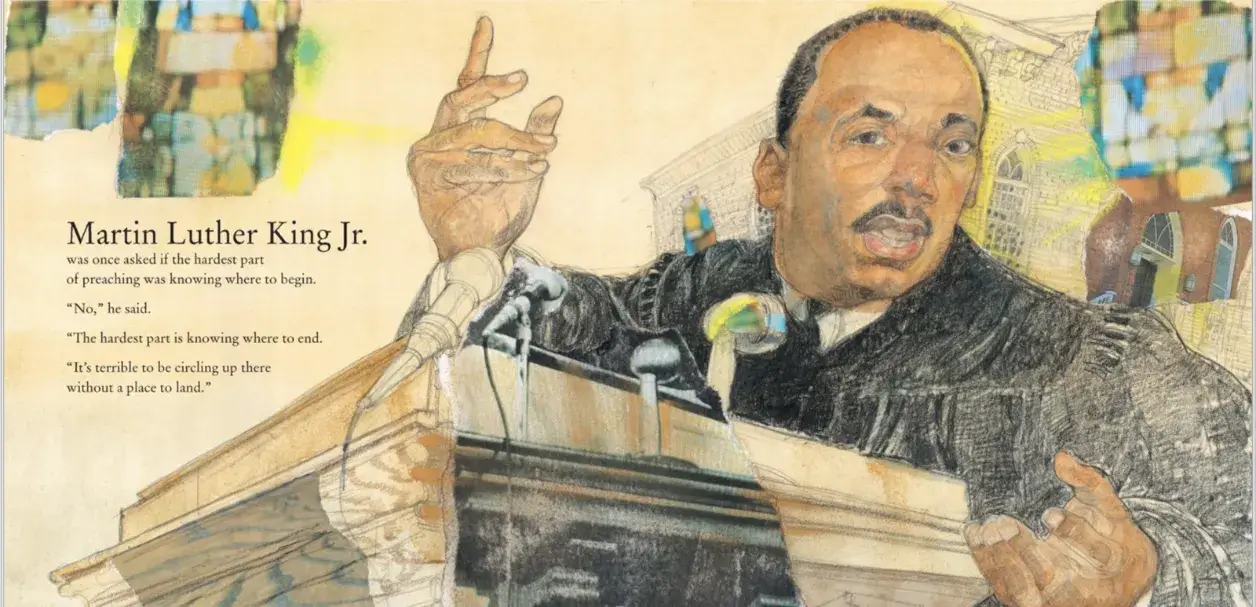There are hundreds of books dedicated to exploring the life, dreams, and work of Dr. Martin Luther King, Jr. Among picture books alone, approaches to King’s story include cradle-to-grave biographies, roundups of his famous speeches and quotes, and deep dives into stories of the March on Washington, the Montgomery Bus Boycott, his memorial in Washington, D.C., and more.
So how’s a parent to choose which books are best to explore with their child?
Here are a few of my top tips for finding the right-fit book to deepen your child’s knowledge of Martin Luther King, Jr.’s legacy and the American history it so vividly illustrates, plus write-ups of some great options curated by early childhood educator Chrysta Naron.
Explore Young MLK Jr.
Be sure to read books that depict King’s early life and his development into a Civil Rights Movement leader in adulthood. Stories that show King as a child and trace his rise in stature (and impact) help kids begin to see the roots of their own greatness—how their circumstances, education, and choices as young people today forge their futures.
Here are some great options:
Martin’s Big Words: The Life of Martin Luther King Jr. by Doreen Rappaport
This is a lovely choice because of the ways it seamlessly weaves historical context with direct quotations to illustrate how King learned to use “big words”—powerful, poetic, persuasive words—to fuel social change.
My Brother Martin: A Sister Remembers Growing Up with the Rev. Dr. Martin Luther King Jr. by Christine King Farris and illustrated by Chris Soentpiet
It’s often easy to place people on pedestals and think of them in just one light. King was a great man with incredible vision, strength, empathy, and fortitude. But he was also a little brother. He was a prankster, a friend, and the son of a preacher. My Brother Martin provides a personal and intimate look at King’s childhood and upbringing through the eyes of his sister, Christine King Farris. It offers insights into their family life, experiences, and the early influences that shaped him into the iconic civil rights leader he became. If you love a good origin story, this one is tops.
Put Leadership in Context
King is such a widely recognized historical figure that it’s easy to assume that kids know more about the man and the details of his life story than they really do. Years of Black History Month presentations and “I Have a Dream” speech snippets often don’t add up to a deep knowledge of what exactly King stood for, what he aimed to accomplish, and how he went about the work.
So be sure to include a solid chronology, such as I’ve Seen the Promised Land by Walter Dean Myers, in the mix of books you choose. And Martin Rising: Requiem for a King presents the final months of King’s life in verse.
My Daddy, Martin Luther King Jr. by Martin Luther King III and illustrated by AG Ford is an excellent way to get into King’s story from the perspective of his son. Martin Luther King III is a human rights activist who followed in the footsteps of his father. In 2013, he took pen to paper and crafted this lovely children’s book about his relationship with his dad.
The book explores the loving relationship King had with his children and how his work influenced their lives. What would it have been like to have been the son of such a prominent man? This book shows King’s life and values from another angle we rarely see. It is a touching book that makes this historical icon that much more knowable to us.
And while King’s “I Have a Dream” speech (or a segment of it) is a staple in classrooms across the United States, it’s also worth delving into the text of that most-famous and most-quoted speech. The book I Have a Dream, lusciously illustrated by Kadir Nelson, is a beautiful and accessible way to enhance your child’s understanding. This rendition brings King’s words to life for young children, making the message more accessible and engaging. For an even more immersive experience, consider playing a recording of King’s delivery of the speech as you go through the book.
Keep in mind that the segregation, violence, and injustice of the Civil Rights era (and today) is difficult subject matter, but books needn’t be relentless in their focus on the tough stuff. Particularly with denser, more challenging material, kids crave and respond to a little digression now and then to lighten the cognitive load. Look for books that use info boxes and other graphic elements to keep things engaging. Take this page from Martin Luther King Jr. in His Own Words by Ryan Nagelhout. The eye-catching bookmark illustration and “More to Know” boxes break up the main text and deliver fascinating tidbits.

Go Behind the Scenes
Although history is often told with a focus on great men doing big things, the reality is that many people participate in the slow march toward progress. One of my absolute favorite behind-the-scenes books is A Place to Land: Martin Luther King Jr. and the Speech That Inspired a Nation by Barry Wittenstein. The text describes the making of the “I Have a Dream” speech, alongside gorgeous illustrations by Jerry Pinkney that show the faces of those who helped King craft his message and the numerous everyday heroes who inspired its content. Young readers will gain valuable insights into the collaborative, deliberative nature of writing to fuel social change.
As a Kirkus reviewer wrote, “Wittenstein’s free-verse narrative perfectly captures the tension leading up to the speech as each adviser urged his own ideas while remaining a supportive community. Pinkney’s trademark illustrations dramatize this and the speech, adding power and further illuminating the sense of historical importance. Gives readers a fresh and thrilling sense of what it took to make history.”
Another excellent option is The Youngest Marcher by Cynthia Levinson and illustrated by Vanessa Brantley Newton. It’s a touching exploration of the Civil Rights Movement, suitable for both parents and their young children. The book beautifully narrates the remarkable story of Audrey Faye Hendricks, the youngest participant in a pivotal moment of the movement.
Through vibrant illustrations and age-appropriate language, it introduces young readers to the profound impact King’s teachings had on Audrey’s courageous stand against segregation. This book serves as an accessible and engaging tool for initiating conversations with children about the values of equality, justice, and the enduring legacy of the movement for civil rights. It also offers a wonderful opportunity to understand the impact of King’s personal relationships on individuals like Audrey.
More books that show MLK in community with others to make change include:
- Memphis, Martin, and the Mountaintop: The Sanitation Strike of 1968 by Alice Faye Duncan
- The Teachers March!: How Selma’s Teachers Changed History by Sandra Neil Wallace and Rich Wallace
- Martin & Mahalia: His Words, Her Song by Andrea Davis Pinkney & Brian Pinkney
Grapple with the Big Ideas
Older children who know King’s biography may be ready to dive into less straightforward accounts of his legacy. Faith Ringold’s My Dream of Martin Luther King explores King’s legacy through the deeply personal lens of a dream the artist had.
“In my dream, Martin appeared first as a child in a place so huge that it encompassed the whole world and all its people,” she writes in an opening scene. “There were children and old folks, men and women of all colors, races, and religions. They carried bags containing their prejudice, hate, ignorance, violence, and fear, which they intended to trade for hope, freedom, peace, awareness, and love. Some people had bigger bags than others, but everybody had something to trade.”
Touching on America’s terrible history of discrimination, violence, and segregation, the book ultimately points toward progress and optimism born of imagination. Abstract, yet resonant, it spurs more sophisticated conversation about the nature of our waking dreams and the path to accomplishing them.
Like this post? Share it!


